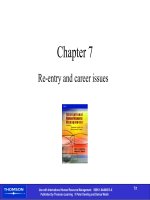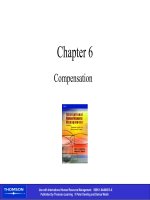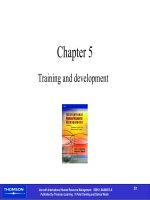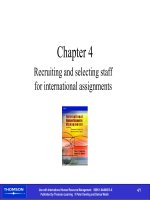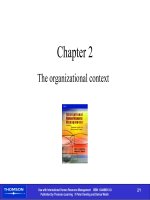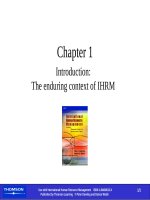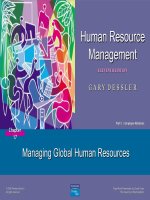International human resource management - Chapter 7 pptx
Bạn đang xem bản rút gọn của tài liệu. Xem và tải ngay bản đầy đủ của tài liệu tại đây (705.45 KB, 22 trang )
Use with International Human Resource Management ISBN 1-84480013-X
Published by Thomson Learning © Peter Dowling and Denice Welch
7/1
Chapter 7
Re-entry and career issues
Use with International Human Resource Management ISBN 1-84480013-X
Published by Thomson Learning © Peter Dowling and Denice Welch
7/2
Chapter objectives
•
the process of re-entry or repatriation
•
job-related issues
(cont.)
Whereas the preceding chapters concentrated on the
management and support of international assignments, this
chapter deals with what could be called the post-assignment
stage. Re-entry, though, raises issues for both the expatriate
and the multinational, some of which may be connected to
events that occurred during the international assignment. We
treat this stage as part of the international assignment. We
examine:
Use with International Human Resource Management ISBN 1-84480013-X
Published by Thomson Learning © Peter Dowling and Denice Welch
7/3
Chapter objectives (cont.)
•
social factors, including family factors that affect re-entry
and work adjustment
•
multinational responses to repatriate concerns return on
investment (ROI) and knowledge transfer
•
designing a repatriation programme.
Use with International Human Resource Management ISBN 1-84480013-X
Published by Thomson Learning © Peter Dowling and Denice Welch
7/4
Re-entry
•
Expatriation process also includes
repatriation: the activity of bringing the
expatriate back to the home country
•
Re-entry presents new challenges
–
May experience re-entry shock
–
Some exit the company
Use with International Human Resource Management ISBN 1-84480013-X
Published by Thomson Learning © Peter Dowling and Denice Welch
7/5
Figure 7-1: Expatriation includes repatriation
Use with International Human Resource Management ISBN 1-84480013-X
Published by Thomson Learning © Peter Dowling and Denice Welch
7/6
Figure 7-2: The repatriation process
Use with International Human Resource Management ISBN 1-84480013-X
Published by Thomson Learning © Peter Dowling and Denice Welch
7/7
Repatriation phases
•
Preparation - developing plans for the
future; gathering information about the new
position
•
Physical relocation
•
Transition
•
Readjustment - coping with change
Use of relocation
consultants and removal
firms
Use with International Human Resource Management ISBN 1-84480013-X
Published by Thomson Learning © Peter Dowling and Denice Welch
7/8
Individual reactions: job-related
•
Career anxiety
–
No post-assignment guarantee of employment
–
Loss of visibility and isolation
–
Changes in the home workplace
•
Work adjustment
–
The employment relationship and career expectation
–
Re-entry position
–
Devaluing of international experience
•
Coping with new role demands
•
Loss of status and pay
Use with International Human Resource Management ISBN 1-84480013-X
Published by Thomson Learning © Peter Dowling and Denice Welch
7/9
Figure 7-3: The repatriate’s role
Use with International Human Resource Management ISBN 1-84480013-X
Published by Thomson Learning © Peter Dowling and Denice Welch
7/10
UK repatriate study
•
Survey of 124 recently repatriated employees
•
Data analysis indicated five predictors for
repatriate maladjustment (in ranked order):
–
Length of time abroad
–
Unrealistic expectations
–
Downward job mobility
–
Reduced work status
–
Negative perceptions of employer’s support
N. Forster (1994) The Forgotten Employees? The Experience of Expatriate Staff Returning
to the UK, International Journal of Human Resource Management, 5 (2): 408
Use with International Human Resource Management ISBN 1-84480013-X
Published by Thomson Learning © Peter Dowling and Denice Welch
7/11
Figure 7-4: The readjustment challenge
Use with International Human Resource Management ISBN 1-84480013-X
Published by Thomson Learning © Peter Dowling and Denice Welch
7/12
Individual reactions: social factors
•
International experience can distance the
repatriate (and family) socially and
psychologically (eg. Kingpin syndrome)
•
Each family member undergoing
readjustment
•
Re-establishing social networks can be
difficult
•
Effect on partner’s career
Use with International Human Resource Management ISBN 1-84480013-X
Published by Thomson Learning © Peter Dowling and Denice Welch
7/13
Multinational responses
•
Staff availability
–
How repatriation is handled is critical
•
Return on investment (ROI)
–
Defining ROI in terms of expatriation
–
Gains accruing through repatriated staff
•
Knowledge transfer
–
A one-way activity?
–
Tacit and person-bound?
Use with International Human Resource Management ISBN 1-84480013-X
Published by Thomson Learning © Peter Dowling and Denice Welch
7/14
Difficulties in measuring ROI
•
Receiving feedback from the business unit
concerned
•
Tracking international assignments in a
systematic way
•
No formal planning
•
Lack of objective measures
•
Too many decisions made without cost
considerations
From responses to GMAC-GRS 2002 survey
Use with International Human Resource Management ISBN 1-84480013-X
Published by Thomson Learning © Peter Dowling and Denice Welch
7/15
Table 7-1: Topics covered by a repatriation program
Use with International Human Resource Management ISBN 1-84480013-X
Published by Thomson Learning © Peter Dowling and Denice Welch
7/16
The use of mentors
•
Aims to alleviate the ‘out-of-sight, ‘out-of-
mind’ feeling by keeping expatriate
informed
•
Mentor should ensure that the expatriate is
not forgotten when important decisions are
made re positions and promotions
•
Effective mentoring needs managing
Use with International Human Resource Management ISBN 1-84480013-X
Published by Thomson Learning © Peter Dowling and Denice Welch
7/17
Chapter summary
•
The repatriation process. One may conclude that in re-entry, the broader socio-cultural
context of the home country takes a backstage position – unlike in the expatriation
adjustment phase, where the foreign culture can be overwhelming. Cultural novelty has
been found to affect adjustment and, for the majority of repatriates, coming home to the
familiar culture may assist in readjustment. Indeed, given the more profound effect that
job-related factors appear to have, re-entry shock is perhaps a more accurate term to
describe the readjustment process experienced upon repatriation.
(cont.)
This chapter has been concerned with the repatriation process. We
have covered:
Use with International Human Resource Management ISBN 1-84480013-X
Published by Thomson Learning © Peter Dowling and Denice Welch
7/18
Chapter summary (cont.)
•
Job-related issues centered on career issues upon re-entry. Factors
that affected career anxiety were no post-assignment guarantee of
employment, fear that the period overseas had caused a loss of
visibility, changes in the home workplace that affect re-entry
positions and the employment relationship. The re-entry position
was an important indicator of future career progression and the
value placed on international experience. Coping with new role
demands was another factor in readjustment, along with loss of
status and pay.
(cont.)
Use with International Human Resource Management ISBN 1-84480013-X
Published by Thomson Learning © Peter Dowling and Denice Welch
7/19
Chapter summary (cont.)
•
Social factors explored were loss of social standing – the kingpin
syndrome – and the accompanying loss of the expatriate
lifestyle. Family readjustment was also important. A specific
aspect was the effect of the international assignment upon the
spouse/partner’s career, such as being re-employed and having
international experience recognized.
(cont.)
Use with International Human Resource Management ISBN 1-84480013-X
Published by Thomson Learning © Peter Dowling and Denice Welch
7/20
Chapter summary (cont.)
•
Multinational responses to repatriates’ concerns focused on re-
entry procedures. We looked at how repatriation affected staff
availability, whether companies were measuring and obtaining a
return on investment through international assignments and the
contribution of repatriates to knowledge transfer.
•
Designing effective repatriation programs, including the use of
mentors.
(cont.)
Use with International Human Resource Management ISBN 1-84480013-X
Published by Thomson Learning © Peter Dowling and Denice Welch
7/21
Chapter summary (cont.)
Although the focus of this chapter has been repatriation in the
general sense, the issue of career expatriates should be raised. The
repatriation literature reviewed in preparation for this chapter makes
little mention of the process of managing the return of those who
have been part of the international team of managers (or cadre) –
those who have worked outside their home countries for lengthy
periods of time. For this strategically important group of employees,
at some point repatriation may coincide with retirement. One is left
with the impression that those who return to retire in their home
country are no longer of concern to their firms.
(cont.)
Use with International Human Resource Management ISBN 1-84480013-X
Published by Thomson Learning © Peter Dowling and Denice Welch
7/22
Chapter summary (cont.)
However, one could expect that these individuals would require
special counselling to assist not only the transition back to the home
country, but also from work to retirement.
Viewing repatriation as part of the expatriation process, as
suggested in Figure 7-1, should remind those responsible for
expatriation management of the need to prepare repatriates for re-
entry and to recognize the value of the international experience to
both parties.


